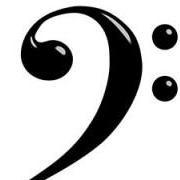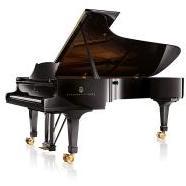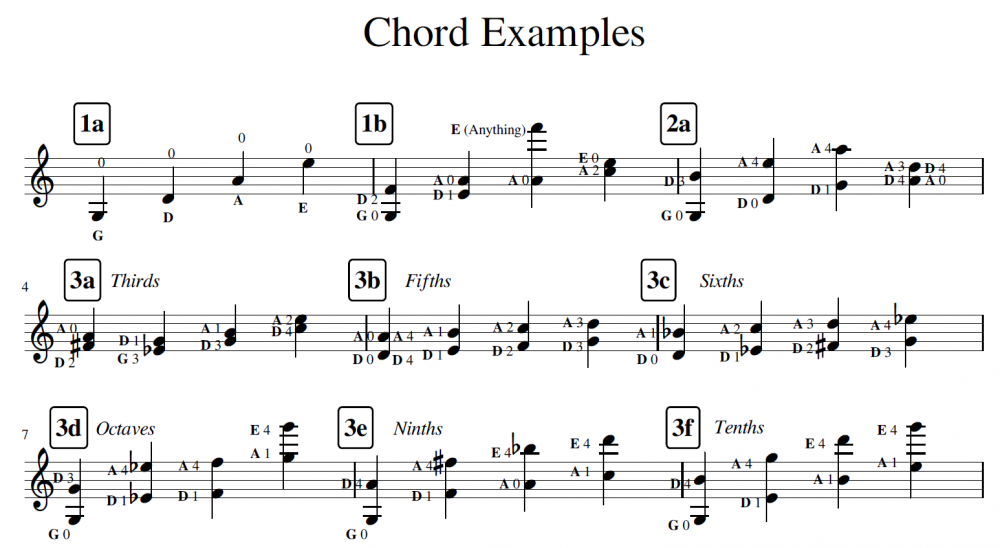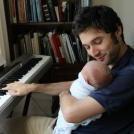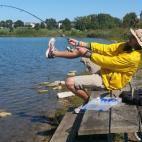Search the Community
Showing results for tags 'violin'.
-
The idea behind the first part of this movement is the growth of material from one note to its full statement. The clarinet, trumpet, violin, vibraphone, and trombone all play there own material treated in this manner. Each statement introduces a new note to their material. The bassoon and bass provide a sonic backdrop to this unravelling. I plan on expanding on this idea in other works -this was a fun idea to work on. Hope you enjoy.
-
I always wanted to write something for violin because is one of my favorite instruments allong with guitar and piano, so I decided to write a preludio and allegro (that was some time ago). But when I showed it to one friend of mine who is a violinist, she said that more than a prelude it feels like and etude because of the very high notes in measures 12,13,28,29,56 and 57. So, i would like a second, third etc opinion about that. For all the violinist out there, are those notes that hard to play, and how is the prelude overall?. Thanks in advance for all the comments :3.
-
I started this quintet with the intention of entering this into a competition -so, I've been working pretty intently on it (to the point that it's all I think about). Here are the first 2 movements: 1. Andante: The first movement serves as a sort of introductory movement. The movement utilizes the short two bar theme presented in the opening (this theme also permeates large portions of the work as a whole). The theme is presented in all voices, leading to the establishment of a 'hopefully' hypnotic pattern -through which I play with the theme and introduce contrapuntal material. The structure is ABA'. 2. Allegro Con Fuoco: This is the movement so far that I've spent the most time on -and this is revision number 4. The opening two bars introduce an ostinato pattern that is taken up by ALL instruments within the quintet. This movement is meant to be faster than what I have set. I've slowed it down to give more attention to detail. 3. Adagio Semplice: To compliment the 2nd movement -and in stark contrast texturally- this movement is more of a mediation and prayer-like movement. The movement is slow and contemplative. At any rate, I'll post the final 2 movements once I've finished them. Hope you all enjoy these experiments.
-
Hey everyone, Here is the piece I composed this semester for my composition lessons at university. It's about 18 minutes long, so if you only want to listen to and review a small portion, that's totally fine. This piece is still under revisions, so any feedback is welcome. Thanks! https://www.youtube.com/watch?v=C2Z780ZKZIY
- 3 replies
-
- large ensemble
- violin
- (and 6 more)
-
I was wondering if anyone can recommend some songs with violin/viola solos along with an orchestra?
-
Hello all. I have recently remembered about this piece that I composed for a workshop back in June. The pieces were recorded at the end of it, and I can share it with you now. I decided to write for Piano Trio. The movement starts and ends in A major, but has sections in other keys. It is in a rough sonata form with two contrasting themes. The main idea has a seemingly random dotted rhythm, but it actually fits in a 5/4 beat shown at the end. The second theme also fits into the 5/4 section for its recapitulation. I am mostly happy with the recording, except for perhaps the final few bars. We only had one rehearsal before the performance and recording so I thin kwe did well. Any mistakes by the violin and cello are due to under rehearsal - any mistakes by the piano are due to me not practising enough beforehand! Hope you guys like it.
-
It is often for composers to add chords in Violin repertoires to enrich the harmony and enhance the virtuosity. However, there are rules ought to be followed in composing to make the work playable. Here I would like to share some tips in chord writing for Violins. 1. Open String Chords It is important to know the 4 open strings of Violins: G, D, A, E. [Fig. 1a] Technically, it is almost always possible to play a chord with an open string and a note on neighbouring string(s). [Fig. 1b] 2. Substitutions It is possible to substitute a note, with its equivalent on a higher positions on a lower string, in order to avoid string crossing problems. For instance, in [Fig. 2a], the first chord is not playable if we choose to play the B note on the A string (A1, first position), as it will skip the D string. However, it is playable if we substitute A1 by D3 (3rd position), and now it is a chord with notes on 2 neighbouring strings, G and D. Such technique is particularly useful for 9th and 10th, which I will mention in latter sections. For the fourth chord, this time if we pick the A note as an open string note (A0), both notes will lay on the same string. Impossible. Therefore, to make it playable, we can either substitute A0 by D4 while keeping the A3, or substitute A3 by D(Anything) while keeping A0. 3. Common Practice for Intervals For 3rd's, we use 0-2, 1-3, 2-4 or 3-1 (or in the reversed order). [Fig. 3a] For (perfect) 5th's (or equivalently diminished 6th's), we use the same fingering for both notes. (i.e. 0-0, 1-1, ..., 4-4) [Fig. 3b] For 6th's, it is essentially a 5th with the upper note shifting higher. So the fingering is 0-1, 1-2, 2-3, 3-4. [Fig. 3c] For 8th's, the most common fingering is 0-3 (when it involves an open string) or 1-4. [Fig. 3d] For 9th's, it is essentially an octave with the upper note shifting higher. So the fingering is 0-3/0-4 (when it involves an open string) or 1-4 (stretching 4th finger!). [Fig. 3e] For 10th's, 1-4 (intensely stretching 4th finger!). [Fig. 3f] These are some fundamental rules for chord writings on Violins. Questions or example discussions are welcomed. HoYin
-
A short piece for violin and piano 🙂 Sounds very classical. I also got a little limited by my poor knowledge of keyboards… One has to practice … 😉
-
What can I say about love? It never turns out quite the way we expect. Then again neither does life. The years stack up, and the weight of all that time compacts our experiences, until we are forged into something new, like metamorphic rock. A good marriage has the same effect. As the years pile up, any cracks that once existed between us are compressed, our minds and outlooks are reformed, until after a while we have been reshaped, remade together. This music chases love, chases life. It races ahead, keeps the fire lit. It’s hunting, sniffing something out, hungrily searching through the night. The years fly by, but the fire stays lit. It’s a dance, a celebration, though a frenetic one. While you listen, stomp your foot! How about one loud clap! Why the hell not! I have a limited vocabulary for describing how it feels to experience love, real love, so I have to compose instead, to try and capture the uncapturable. This music gives just a taste of that. Love has many flavors, and this is one flavor I’ve tasted, and I want to share the feeling with the world. It may not always be pretty, but it tries hard to live passionately, to expresses itself freely, to communicate something meaningful. It doesn’t give up, even when challenges arise. It reaches out to feel a connection. It aches for it. I have experienced this love. In fact, I experienced it today, while watching my wife walk across the room. Sometimes my heart starts pounding for no reason, and this music appears inside my brain. Makes me want to spin around and around, until everything is blurry. The life we have built, the family we created, the years and shared experiences and adventures are all stacking up before me, until all I can do is marvel at the structure. Keep living! Keep love in your heart, and share it with someone whenever possible. Stomp and dance and spin. And also, lay silently on your bed in the afternoon with the person you love, and watch the sun’s rays poke through the blinds. Compare the sizes of your feet, tell a silly story, share what’s in your heart. Grow together, always growing.
-
Hi forum 🙂 A short attempt at a duet between a tuba and a violin...Duo pour tuba et violon.pdf
-
Hey gang, I posted this piece earlier when I was in the middle of writing it. Here is the finished product. This is the piece I composed over the spring semester during my first semester of composition lessons at the university I am attending. Please enjoy and let me know what you think! (P.S. Evidently when you use Petrucci font in Finale, the tremolo stops working, so that's why it appears in the score, but is not in the MP3 [do the midi problems ever end...?])
- 1 reply
-
- string quartet
- strings
-
(and 7 more)
Tagged with:
-
Fin.mp3 A short piece intended for film
- 2 replies
-
- film score
- brass
-
(and 2 more)
Tagged with:
-
violin Dance of the Snowflakes- Piano and Accompanist
EquillaBeasley posted a topic in Chamber Music
This is a violin and piano accompanist piece that is made to depicted snowfall and anything related to snowflakes. You should be able to hear this and enjoy the piece too. -
Guten Tag! This is one of the projects I have been working on this semester! Feel free to check out the concept behind it at this blog post: Composition Notebook: "Morning Birds" - the story. What I am attaching for ya'll is the full score (which includes the cues for the three different flute parts, but not the actual parts), one of the flute parts (so you can see what they look like), a MIDI rendering of all the orchestra and flute parts combined, and a MIDI rendering of just the orchestra part (Titled "Three Violin Version..."). One of the flaws of the combined MIDI file is that the flute parts are made up of several short fragments/'bird calls',as you will see in the attached flute part, and the players will be improvising which bird call they play when. In other words, it will be a much more organic process than a computer just playing them all in order, as happens in the recording. I think the MP3 of everything combined sounds pretty terrible and clamorous which is not at all the intent of the piece. I suspect that this chaos will be lessened considerably when real players are performing this. If anyone has experience writing this sort of thing, I would really appreciate any advice you'd have to offer. Also, I am happy to hear comments from anyone about this piece, whether they be about the orchestral writing, the special effects, or anything else. Thank you and enjoy!
- 3 replies
-
- chamber music
- orchestra
- (and 11 more)
-
Hello everyone. I'm new to this forum but i'm hoping i can get some much needed help. I recently started working on my very first musical composition and it has multiple sections. The "B" section is a Waltz that preferably needs to be in E Minor. I've never written a Waltz or Classical music in general. so it would be much appreciated if i could have some ideas on how to take it. Thanks, Weston
-
Hey there, Here is another piece which I have been working on this semester! I really need to come up with a fun title, so if anyone has any ideas, please share! Also, I am happy to hear any comments on this work. It is in four movements, and I hope that you enjoy each of them (my personal favorite is the third one - 'Largo').
-
- string quartet
- strings
-
(and 6 more)
Tagged with:
-
This is my first attempt to write a piece for unaccompanied violin. I'll try to make a recording in nearest future
-
My master's degree is starting to draw to a close, and I'm very aware that every piece I write now will be one of the last while I still have my tutor. For that reason, I've really tried to push myself beyond my current boundaries wherever possible. This piece, while not incredibly 'contemporary' sounding I suppose, in some ways represents the culmination of my efforts and explorations while at this institution. I've pushed my harmonies and chord progressions as far as I'm personally willing to right now, and also used some new string techniques that I'd not really explored before. Some of this piece, especially the second half, is definitely among my favourite music I've ever written. I've still kept to my usual style of working with very short bits of material and seeing where I can take them, but this piece is roughly divided into three or four smaller sections which have their own separate ideas as well. I've also become very interested lately in sounds that 'morph' over the course of a single note. Usually, that just means fading multiple instruments in and out on the same note. I feel that this is an area that isn't adequately explored in a lot of the more widely played contemporary repertoire, especially in more amateur-aimed music. This piece will be performed at the start of May by a professional ensemble (including a very skilled concert pianist, fortunately). It'll be conducted, which is why I put the piece in this section. I've put it on Soundcloud as well if that playback is working better than this site for whatever reason. There's a couple of really minor changes between the score and the recording, because once you start polishing the score in Sibelius you often kind of ruin the playback.
-
@ComposerMITA wrote a piece a few weeks ago based on a concept of lines which function relatively independent of one another and which also change 1) tonal centers and 2) modes every couple measures. It sounded like an interesting experiment, so I thought I'd give it a whirl. I-dunno, I don't hate it exactly, but it sits with me the same way that free jazz and 12-tone music do. *shrug* It's definitely a good exercise in modes, in part writing, and in trying to make each line work on its own regardless of the others. The original project requirements call for no thought given between the lower two voices and the upper two voices, but I must admit to breaking that a little - if it was possible and convenient to the line, I definitely gravitated towards tones that worked relatively better with the other parts! Viola! - erm, I mean VOILA - c'est mon "chef d'oeuvre". Gustav
-
Audio: Allegro.mp3 Score: Allegro TOTALLY DONE.pdf The date was September 24, 2006, my 22nd birthday. Erica and I decided to have a picnic in Meadow Park, share a bottle of wine, and take a nap. It was during this wine-induced nap that somebody walked into our house, in the middle of the day no less, while we slept peacefully in the bedroom, and stole my laptop. This particular laptop happened to contain all the music I had ever written up to that time. Was it backed up somewhere? Of course not. After all, my laptop had never been stolen before, so why would I need to back up everything I'd ever created. Nope, it was all right there, and someone stole it right out of my house in broad daylight. I never saw it again. The thief did not take our DVD player. He did not take our television. He did not take my car keys or the stereo either. He didn't even take the laptop's power cord. Just the laptop. And of course my very reason for living. When I awoke from my cat nap, it took me a good half hour to realize the laptop was gone. I won't try to put into words what went through my head except to say this: all of my art was destroyed that day. I had no website, no hard drive, no printed copies. I felt like a victim of fire. I was completely alone with my grief. Ok I was able to salvage a couple things. While ravaging through my belongings looking for any sheet music I could find, I miraculously discovered some printed pages stuffed down into a drawer. The pages were the original versions of what would later become the third and fourth movements of my first piano sonata. I was also able to copy down from memory the scraps that would later become the last movement of my first string quartet. Other than those tidbits, everything else was taken forever. My entire career as a composer up to that point was a blank page. I'm not sure how long I waited until I tried to sit down and write something again. Maybe a month. Whenever it was, when I sat down in front of that blank page, I actually felt very free, despite my sadness (and rage). It was as if all my musical baggage had been tossed unceremoniously in the trash can. Whatever genre I had been trying to fit into, whatever musical puzzle I had been wrestling with, whatever inadequacies I felt about my completed work - they were all completely moot now. I was born anew. So I sat down and wrote a violin sonata. I had never written for the violin before, but my approach was to write as if the instrument could do anything I wanted it to do. I wrote that way for the piano too. No more feeling constrained by my own lack of pianistic ability. I put on that page whatever I damn well felt like. It felt good. And somehow, despite all the pain, the music was chipper. Even at my darkest moments, my music comes out chipper. Maybe it's just who I am, or maybe that's how I cope. My brain might feel all doom and gloom, but my music is sunshine and rainbows. This first movement is the first piece I wrote after my babies were taken from me. I completed the movement in March of 2007. It is very much a classical piece, straight up sonata form, repeat bar and everything. It might not be genre shattering, but it was a very open and freeing experience for me to write it. It's what I was feeling at the time. It's what had to come out.
-
Hi everyone, I am starting to plan my next symphony, for a standard orchestra. I am having trouble with knowing what difficulty to make the second violin parts. The 1st violins play semiquaver triplets, with 6 to a beat at 90MM (ish.) I have been told this is okay for 1st Violin, but should I give a part of this speed to the 2nd violin/viola? The other thing I thought of doing was dividing the sections, and having the other half play pizzicato on every quaver. Would doing this cause the strength and resonance of the strings to be lost under the winds?
- 2 replies
-
- violin
- 2nd violin
-
(and 2 more)
Tagged with:
-
This is my first piece in italian style and generally my first concerto (I don't think it's succesful), I write mostly solo music. What do you think? What do I have to improve?
-
Perendinare is a latin word that has no representation in Spanish. It means: "to leave something for the day after tomorrow".


